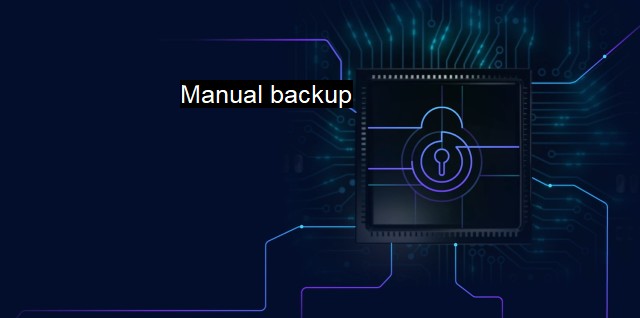What is Manual backup?
The Role of Manual Backup in Cybersecurity: A Comprehensive Analysis of Traditional Backups and Modern Backup Technologies
Manual backup refers to the process of copying or archiving data physically, in a way initiated by the user, instead of being automated. This procedure is highly valuable in any instance of data corruption, mishap, loss due to computer failures, cyber attacks, or a severe malware intrusion which some antivirus programs may not fully shield against. Manual backups, when done judiciously in conjunction with cybersecurity measures, drastically reduce the risks of data theft or loss, contributing both to data recovery and to maintaining data integrity.One of the primary reasons manual backup is essential in the realm of cybersecurity and antivirus protection is that ransomware attacks have become an increasingly common threat. These cyberthreats work by malicious software encrypting a victim's files and then demanding a sum of money to recover them. If the victims do not have a manual backup of their data, they largely have no choice but to pay the money to have their data restored, under the assumption that the cybercriminals will indeed restore them. if a manual backup has been prepared, the victims would still be able to recover their files, negating the power of the attackers.
Adding to this, despite software advancements and the incorporation of intelligent automated cybersecurity solutions, no antivirus can be predicted as being entirely foolproof. While high-level commercial antivirus software can ward off most of the cyber threats, it cannot keep track of every unpredictable and novel virus. Hence, it is well-advised to conduct a manual backup religiously to ward off potential unforeseen losses.
In the corporate context, companies often have to abide by laws and regulatory demands to provide specific data records covering a specific time-period for auditing in case of discrepancies. Hence, manual backup can serve as a handy data reserve during such urgencies. It further enables companies to be resilient by ensuring business continuity in the aftermath of harmful cyber incidents.
Manual backups can be stored in different formats and storage media with varying capacities to cater to personal or organizational needs. These backups could include anything from hard drives & SSDs to removable storage like CDs, DVDs, and pendrives, or even tape backups. More recently, individuals and businesses also use cloud backup services. always remember to encrypt and maintain privacy while storing data, irrespective of the medium.
Several steps are in place to ensure an adequate manual backup process. These include identifying the data that needs backing up, which generally are the files that would result in a loss of time, money, or business if destroyed. Then, choosing an adequate, secure backup location, and determining a regular backup schedule are also equally vital.
Despite the advantages, it is important to address that manual backup is a time-intensive process that executes systematically without the option of multi-tasking, often requiring constant human intervention. perceived in correlation with cybersecurity and antivirus protocol, the benefits of enacting manual backup undeniably surpass its minor drawbacks.
Manual backup acts as the last resort in salvaging data in multiple dangerous cyber-attack scenarios. It complements antivirus software by providing added security and assuring data safety. Therefore, despite the sophistication level of antivirus software installed, regular manual backups should be an integral part of an individual's or business's cybersecurity protocol. They significantly reduce the impact of data loss, and safeguard digital assets in scenarios where antivirus protection has been compromised, hence contributing to an overall data protection and cybersecurity strategy.

Manual backup FAQs
What is manual backup and why is it important in cybersecurity?
Manual backup refers to the process of manually copying important data or files to a separate storage device or location, instead of relying on automated backup systems. This is crucial in cybersecurity, as it ensures that data is kept safe from potential cyber attacks, malware or viruses that could compromise automated backup systems.How do I perform a manual backup?
To perform a manual backup, simply copy the data or files you wish to backup and paste them onto a separate storage device, such as an external hard drive, USB drive or cloud storage. It's important to keep this backup separate from your main system to ensure it remains safe in case of an attack.When should I perform a manual backup?
It's recommended to perform a manual backup on a regular basis, depending on how frequently you update or create new files. Ideally, you should perform a backup at least once a week, but if you work with sensitive data or files, you may want to do it more frequently. You should also perform a manual backup before making any major changes or updates to your system to ensure you have a backup in case anything goes wrong.Can I rely solely on manual backups for my cybersecurity needs?
No, manual backups should be considered as an additional layer of protection, but they should not be relied on solely for your cybersecurity needs. Automated backup systems, antivirus software, firewalls and other security measures should also be in place to provide a comprehensive and effective cybersecurity strategy.| | A | | | B | | | C | | | D | | | E | | | F | | | G | | | H | | | I | | | J | | | K | | | L | | | M | |
| | N | | | O | | | P | | | Q | | | R | | | S | | | T | | | U | | | V | | | W | | | X | | | Y | | | Z | |
| | 1 | | | 2 | | | 3 | | | 4 | | | 7 | | | 8 | | |||||||